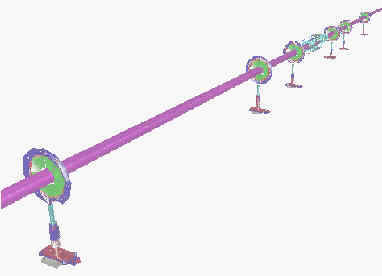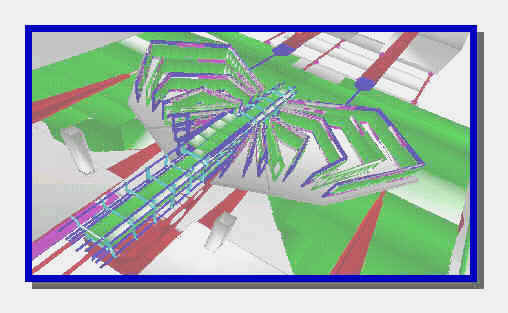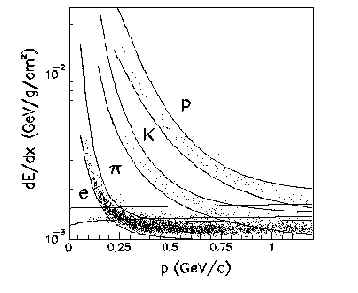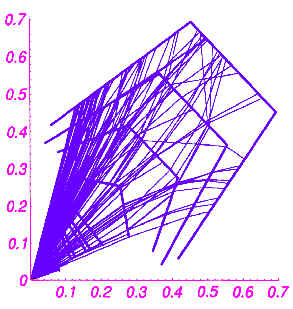Research group
Research
kool sites
research links
University work
Presentations
Workshops
phobos
yahoo
hotmail
UR physics
PAS library
phobosgrouppg
Instr. Access
Advis. Access
AIM
RochWeather
Time
UR FindPeople
Phobos: the motivation and the experiment
S. Manly
Dept. of Physics and Asronomy
University of Rochester
November 6, 1998
Motivation
The fundamental strong nuclear interaction is widely believed to be well described by the non-Albelian gauge theory of quantum chromodynamics (QCD). [1] Many experiments support this point of view: deep inelastic scattering experiments indicate a substructure of spin ½ particles in baryons, providing evidence for quarks; free quarks have never been observed, indicating confinement; the assumptions of three colors and fractional charge are required to account for the observed ratio,
![]()
as a function of q2 or center-of-mass energy; event topologies in high energy e+e- collisions give us visually striking evidence for gluons and yield a particularly straightforward way of measuring the qqg coupling strength; and a consistent value for the effective strong interaction coupling constant is obtained using a wide variety of techniques. [2] This list, though incomplete, is quite impressive. Given this success, it is of the utmost importance to probe and test QCD in every regime possible.
A salient feature of QCD is the vanishing effective coupling constant at large momentum transfer or short distances. The interaction is expected to become weak at extremely high temperatures and/or extremely large densities. This leads to deconfinement and the possibility of forming a quark-gluon plasma (QGP). In addition, the dynamically generated mass of the light quarks that comes from interactions with quark-antiquark pairs in the vacuum (the so-called "quark condensate") is expected to be reduced or vanish at high temperatures and large densities. (Note that this is distinct from the mass that comes from electroweak symmetry breaking!) The removal of this "constituent" mass restores the effective chiral symmetry of the theory, leading to the name of this phenomenon: chiral symmetry restoration. Clearly, it is important to experimentally verify these aspects of QCD and to quantify the deconfinement and chiral phase transitions as precisely as possible.
The primary avenue of investigation into this aspect of QCD is in heavy ion collisions, where extreme conditions of high temperature and/or density can be generated for a short time over a volume that is large relative to the interquark distances. This approach is fraught with difficulties. Even if deconfinement is achieved, the plasma cools and the quarks and gluons will be reconfined into hadrons before they can be observed. Direct probes, such as photons and leptons, hold promise. However, these signatures have relatively large backgrounds that must be carefully modeled. Much emphasis has been placed on looking for changes in the particle production, relative to a hadron gas, due to the fact that the system passed through a QGP phase where a thermal equilibrium was achieved. Implicit in this (usually) is the assumption that the extreme conditions last long enough for the quarks and gluons to reach approximate thermal equilibrium.
So far, this discussion only touches the proverbial "tip of the iceberg". There exists a large volume of literature describing possible signatures of the phase transitions, searches for robust signatures, and results from heavy ion experiments. [3] There will be no attempt to make a careful survey here. However, it is important to point out that the most recent results, coming from experiments running with Pb beams at the CERN SPS, are very encouraging! These results are not without controversy. However, a few recent highlights are mentioned below. [4]
| WA97 has observed a substantial increase in the strange baryon yields (in Pb-Pb collisons at 158 A Gev/c) over what would be the expected scaling from the number of binary nucleon-nucleon collisions. [5] | |
| A hydrodynamical approach with a substantial transverse velocity seems to model well Pb-Pb collisions at 158 A GeV/c. The the measured thermal freeze-out temperature in such a picture is approximately 120 MeV. [6] | |
| In Pb-Pb collisions at 158 A GeV/c, NA50 has observed an anomalous and substantial drop in J/y and y ’ relative to Drell-Yan production as a function of the geometrical mean path length of the state through nuclear matter, i.e., increasing centrality and number of nucleons. [7] | |
| Several experiments have observed a substantial excess of low mass inclusive e+e- pairs over the yield expected from known hadronic sources scaled from pp collisions. Partial chiral symmetry restoration is one explanation that seems to model the data well. [8] |
The next big step in the effort to create and study the QCD deconfinement and chiral phase transitions in the laboratory will take place at the Relativistic Heavy Ion Collider (RHIC) at Brookhaven National Laboratory (BNL) in the second half of 1999. RHIC will have the capability of making Au-Au collisions at a center-of-mass energy of 200 GeV/nucleon pair. It is generally believed that the energy density reached at the center of these collisions will be well over the critical value of 1-2 GeV/fm3 [9] necessary to create a deconfined state.
These events will be examined by an initial complement of four detectors[10]:
| STAR – The dominant feature of this detector is a large TPC inside a solenoidal magnetic field covering the central rapidity region. The event rate will be 1-2 Hz. STAR will make an exhaustive study of hadrons produced at central rapidity, correlating different signatures on an event-by-event basis. | |
| Phenix – This detector is an amalgam of many somewhat small acceptance detectors of varying technologies. Of the four RHIC experiments, this detector has the best capability to study photon and lepton production. In addition, it will have the ability to look at hadron production at central rapidity, albeit with smaller acceptance (but higher rate) than STAR. | |
| Phobos – This is a "single technology" experiment, based on silicon. It contains Si detectors capable of measuring the number of charged particles produced in each angular region on an event-by-event basis over 85% of 4p . In addition, Phobos measures the details of charged hadron production in a small acceptance magnetic spectrometer (with Si sensors) at central rapidity. With the small acceptance offset by a high event rate, this experiment will focus on the physics of hadron production correlated with the global event structure. | |
| Brahms – This experiment consists of two small acceptance charged particle spectrometers, one at mid rapidity and one in the forward region. Over time, the moving spectrometer arms of Brahms will provide a picture of inclusive hadron production with the broadest acceptance at RHIC. |
Many features of these detectors and their upgrade plans are not mentioned here. Each detector has significant overlap with the others as well as the capability to make a unique contribution to the program. Together, they should provide enough information to yield a coherent picture of the collisions at RHIC. Hopefully, this will lead to a deeper understanding of QCD, the state of the universe at t=1m s, and the collective processes that can occur in such collisions.
The Phobos experiment at RHIC
Phobos is pictured on the front of this proposal with the top half of the magnet cut away. It consists of two detectors in one ¾ based primarily on one technology. The first detector consists of a course-grained silicon detector aimed at measuring the particle production on an event-by-event basis, dn/dh df , over approximately the entire region of pseudorapidity where particles are produced in RHIC collisions. See figure 1. This part of Phobos is called the multiplicity detector and is pictured in figures 2. The multiplicity detector consists of » 15,000 channels arranged in an octagon surrounding the interaction point and successive rings providing coverage at extreme pseudorapidity. This detector covers 85% of 4p and has a granularity of D h » 0.1 unit and D f » 0.2 radians.
![]()
Figure 1: Simulation of the reconstructed dn/dh for a single event as a function of h for Phobos.

Figure 2: The Phobos multiplicity detector

Figure 3: The Phobos silicon spectrometer arms.
The other primary detector for Phobos consists of a two-arm multiparticle spectrometer. Each arm of the spectrometer consists of a conventional magnetic coil with a 2 Tesla magnetic field, instrumented with 13 planes of silicon detectors, as shown in figure 3. These detectors provide position measurements for tracking and information on energy deposition for particle ID (via dE/dx) and to aid pattern recognition (see figures 4 and 5). Each spectrometer arm contains » 70,000 channels that cover approximately 1% of the solid angle at central rapidity.

Figure 4: Particle identification via dE/dx at Phobos.

Figure 5: Reconstructed tracks in the Phobos spectrometer.
The silicon detectors are supplemented by time-of-flight walls that extend the momentum acceptance of the particle ID as well as Cerenkov and scintillation counters which provide triggering and background rejection.
Phobos will take a global look at each event with the multiplicity detector and correlate this with details of the particle production at mid rapidity via the spectrometer. RHIC physics is unknown ¾ interesting events may be rare and the signatures may not be what is expected. Phobos intends to take events at a high rate with an unbiased trigger. Offline analysis will uncover any surprises that may await us. With or without major surprises, Phobos will:
| provide a clean measurement of dn/dh df for |h |<5.5 (event-by-event and inclusive); | |
| look for interesting fluctuations in dn/dh df (event-by-event and inclusive); | |
| provide coverage at low Pt (event-by-event and inclusive); | |
| measure different particle production multiplicities, ratios, and Pt spectra (some event-by event, mostly inclusive); | |
| study particle correlations (inclusive); | |
| measure the f mass and width (inclusive). |
References
[1] Good discussions of QCD and some of the basic experimental evidence supporting the theory can be found in the following books:
F. Halzen and A. Martin, Quarks and Leptons: An Introductory Course in Modern Particle Physics, John Wiley and Sons, 1984;
C. Quigg, Gauge Theories of the Strong, Weak and Electromagnetic Interactions, Benjamin/Cummings, 1983;
D. Griffiths, Introduction to Elementary Particles, John Wiley and Sons, 1987;
D.H. Perkins, Introduction to High Energy Physics, 3rd edition, Addison-Wesley, 1987.
[2] P.N. Burrows, Review of a s Measurements, Acta Phys. Polon., B28: 701-723, 1997.
[3] For a recent review of heavy ion physics, see J.Harris and B.Muller, Annu. Rev. Nucl. Part. Sci. 1996, 46:71-107.
[4] For a recent summary, see P.Braun-Munzinger and J.Stachel, Dynamics of Ultra-Relativistic Nuclear Collisions with Heavy Beams: An Experimental Overview, Thirteenth International Conference on Ultra Relativistic Nucleus-Nuclear Collisions, Tsukuba, Japan, December, 1997.
[5] I.Kralik for the WA97 collaboration, Thirteenth International Conference on Ultra Relativistic Nucleus-Nuclear Collisions, Tsukuba, Japan, December, 1997.
[6] G.Roland for the NA49 collaboration, Thirteenth International Conference on Ultra Relativistic Nucleus-Nuclear Collisions, Tsukuba, Japan, December, 1997.
[7] L.Ramello for the NA50 collaboration, Thirteenth International Conference on Ultra Relativistic Nucleus-Nuclear Collisions, Tsukuba, Japan, December, 1997.
[8] I.Ravinovich for the CERES collaboration, Thirteenth International Conference on Ultra Relativistic Nucleus-Nuclear Collisions, Tsukuba, Japan, December, 1997.
[9] E.Laermann, Nucl.Phys. A610 (1996) 1.
[10] The web is a good starting place to find information concerning the RHIC experiments. See the following links:
http://www.rhic.bnl.gov/brahms/WWW/brahms.html; http://www.rhic.bnl.gov/phenix/; http://phobos-srv.lns.mit.edu; and http://www.rhic.bnl.gov/star/ .